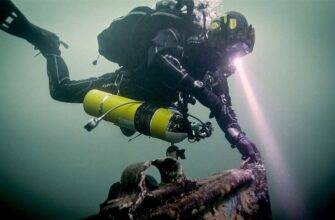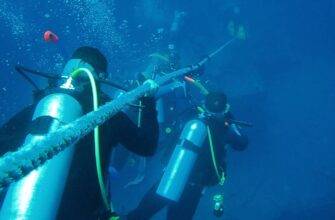To determine the depth knowing the absolute pressure, subtract the atmospheric pressure value (1 ATA) from the absolute pressure value (PATA) AND multiply the difference by 10 msw or multiply the absolute pressure value (PATA) by 10 msw and subtract from that 10 msw corresponding to the effect of atmospheric pressure.
D msw = (PATA – 1 ATA) x 10 msw or D msw = (PATA X 10 msw) – 10 msw
How do you calculate what depth in msw corresponds to 7 ATA?
D msw = (PATA – 1 ATA) x 10 msw D msw = (7 ATA – 1 ATA) x 10 msw D msw = 6 ATA x 10 msw D = 60 msw
or
D msw = (PATA x 10 msw) – 10 msw D msw = (7 ATA x 10 msw) – 10 msw D msw = 70 msw – 10 msw D = 60 msw
The absolute pressure of 7 ATA corresponds to a depth of 60 msw.
Dalton’s Crystal
Dalton’s law states:
“In a mixture of gases, each gas has its own pressure. The pressure of a gas mixture is equal to the sum of the pressures of the gases that make up that gas mixture.” Or more simply: “The pressure of a gas mixture is equal to the sum of the pressures of its constituents.
The formula for Dalton’s law is as follows:
P = Pgl + Pg2 + Pg3, etc.
P is the absolute pressure of the gas mixture,
Pg – pressure of a single gas, designated by numbers 1, 2, 3, etc., is called the partial pressure of the gas.
We know that air and NITROX consist of nitrogen and oxygen. Therefore, Dalton’s formula as applied to them would look like this:
P = PN2 + P02
P is the absolute pressure of air, PN2 is the partial pressure of nitrogen, and P02 is the partial pressure of oxygen.
In atmospheric air, nitrogen occupies 79% of the volume and oxygen 21%. Naturally, the partial pressures of these gases will be proportional to the volume they occupy.
Consequently, the absolute pressure of air at sea level can be expressed as:
1 ATA = 0.79 ATA + 0.21 ATA
If we know the partial pressure of the gas and the absolute pressure of the gas mixture, we can calculate percentage of content of this gas in the mixture. To do this, we divide the partial pressure of the gas by the total pressure of the mixture. The percentage of gas in the mixture, expressed as a decimal, is called the gas fraction and is denoted by Fg.
Fg = Pg : P
Now we can substitute the values of 02 or N2 instead of “g” in this formula and determine the fraction of one or the other gas in air. The oxygen fraction (FO2) is equal to the ratio of the partial pressure of oxygen (PO2) to the absolute pressure of air (P).
FO2 = RO2 : P FO2 = 0.21 ATA : 1 ATA FO2 = 0.21
Substituting the N2 values into the formula, we obtain the nitrogen fraction (FN2):
FN2 = PN2 : P FN2 = 0.79 ATA : 1 ATA FN2 = 0.79
Using the same formula, let’s determine the oxygen fraction (FO2) and the nitrogen fraction (FN2) in the EANx32 mixture. Since oxygen takes up 32% of the volume in the mixture, the oxygen fraction (FO2) is 0.32. Nitrogen takes up 68% of the volume in the mixture, therefore the nitrogen fraction (FN2) is 0.68.
Try to determine the same for mixture EA#36 by yourself. I am sure you will be able to do it.
Read More:




